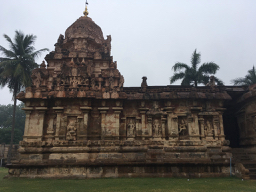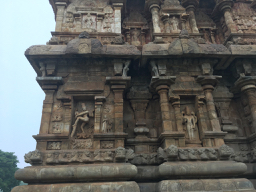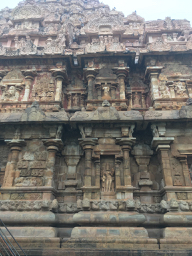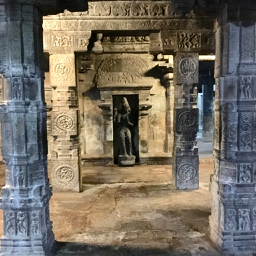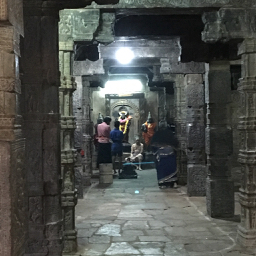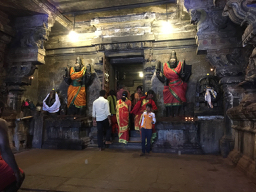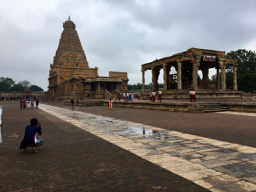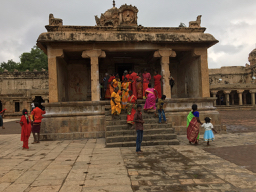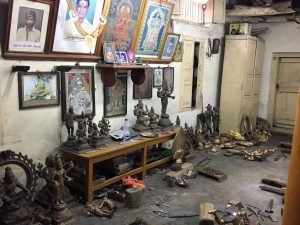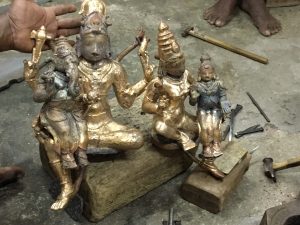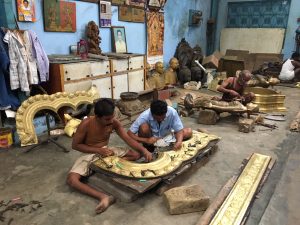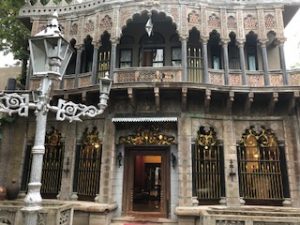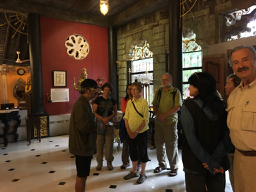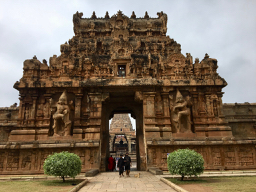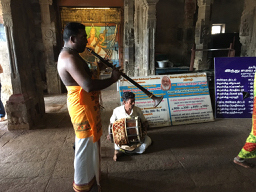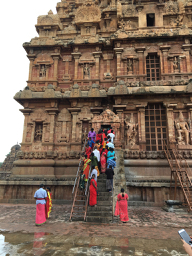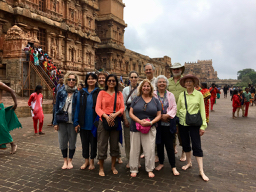The road inland from Tranquebar takes us to the great temples of the Chola dynasty, in full strength from 800-1200 AD,` past agricultural lands filled with the green of newly planted rice paddies and the yellow husks of that already reaped. Small stalls occasionally dot the road, selling the little necessities for rural life. We pass through some larger villages, make a few turns and come to the temple complex located in the town of Gangaikundocholapuram. I practiced this tongue twister a bit before presenting it to the group. Our guide Sekar provides an overabundance of information, both informative and sometimes a little too much for weary travelers.
It begins raining and although large umbrellas are provided from the bus, when we take our shoes off as required, we find ourselves walking through mud and onto wet granite stones around the magnificent structure. Although it is no longer considered an important temple, it was created and carved by great Chola-era artisans and its rising truncated pyramid, or gopuram, is impressive.
The temples all have large solid stone pillars so that the pathway to the holy inner shrine is very dark, usually with fluorescent, sometimes vibrating lights, decorating and directing one’s attention to the main idol. The contrast between the ancient stone and the bright lights is great but seems to fit with all the idiosyncracies of this, in many ways, surrealist country.
Darasurum is a small compact and perfectly formed and decorated temple, with ancient Tamil script running from entrance all around its inner walls, telling the stories of the godheads. We are able to bypass the crowd and go close to the inner shrine, with priority over the faithful, which makes some of us feel a little uneasy with our privilege.
This area, Kumbakonam, is the heart of the bronze-making art which creates the classical images of the various gods and goddesses for temple and personal prayer. We visit one of the great Sthapathy families who for many generations have created the largest statues for temples both within India and for export to Hindu sites around the world. Some of their creations weigh 2 tons. We are shown the lost-wax technique that is used to form the casts which are then filled with a combination of silver, gold, zinc and copper (the first two of far less percentage than in the old days) and, when cooled, carefully hammered out to smooth perfection. The last step is the opening of the eyes, after which the image becomes a living god to whom worship is due.
Our hotel is the fabulous Indeco Swamimalai, filled with antiques collected by the avid, if not obsessed, owner, of the transformation of Indian life by the British from pre-mechanical to the modern age: collections of radios, phonographs, telephones, fans, portable gadgets, as well as glassware and photographs. The owner himself gives us a tour. The main reception hall is a palace saved from demolition and rebuilt, stone by stone, over a years time. The hallways are filled with antiques and each room is different. It is a feast for our eyes and helpful in understanding the intensity of the 100 year stretch of history from 1848 to independence in 1948. The mint palace below and the owner showing us his treasures.
Once again, a delicious dinner at our hotel. And perhaps a few hours sleep.
The next morning in Tanjuvur (Tanjore) is the great Brhadeshvara Temple.We arrive just in time for a special ceremony at the side temple of Paravathi where a shenai player and mridangan drummer announce their devotion to the goddess and pilgrims and local worshippers arrive to present their gifts. Although theoretically, we are not allowed into the inner sanctum as non-Hindus, our guide takes us right before the spot where the priest blesses each devotee while accepting their rupees on the outstretched plate in his hand.
At this temple there is a circle folk dance going on, with a man in the center and women centering around him and moving with music supplied by some musicians. Julie and Jan join the dancers and are very welcomed. The rain has stopped and did not dampen our enthusiasm or our spirits. This world is so full of energy and brilliance, it shines through the dirt and chaos and blooms ever anew, supported by faith and hope.

